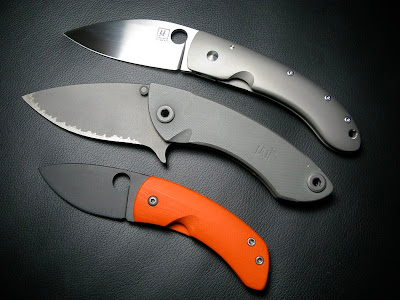Design Influence
Recently, on one of the popular knife forums, there was an instance of someone asking another knifemaker to make his rendition of Bob's Chinese Folder. When the pictures were posted, the end results were too similar to Bob's design that a debate arouse about what is original, and what would constitute a copy. The age old argument that Bob did not invent the design surfaced again. As was the case when Bob introduced the tanto design, he never claimed to have invented the Chinese Folder design, so that accusation is invalid. What he did was based his design on the original, and came up with his own version.
The original design, called the Shi Lin in Chinese, is an ancient design. It was a slip joint with narrow neck and rounded handles. What Bob did was to update the design to modern lines, and added his own design elements. These included a liner lock, a different pivot geometry, and a new curved handle treatment. An additional design element was the use of the licensed Spyderco Hole to help with one hand opening.
The success of the production Spyderco Chinese Folder is what brought the design to the mainstream knife public. Since then, several makers have offered their own interpretation of a Chinese Folder. I've attached two below; the Whaleshark as designed by Johnny Liao and made by Warren Thomas, and the Chinese Friction Folder by my friend Belgian knifemaker Filip Deeuw.

There was a slight rumbling when Warren Thomas's version was made public. Even more when Microtech decided to issue a production version. But Bob's reaction was that, while the Whaleshark was piggy backing off the success of his Chinese Folder, the design was unique enough that it wasn't a "copy" as suggested. The same argument can be said for Filip's version. As well as a fixed blade version that is currently in the works by Tom Krein.
However, the version in question in the first paragraph, had too many similarities, and not enough unique features. The lines of the folder were near identical, down to the blade's grind lines. The argument offered for making these folders were:
1) Bob is no longer available to make Chinese Folders.
2) The maker came to the final design by extrapolating from the Spyderco version, and is unique because it did not include the Spyderco hole and is bolstered.
3) The maker only did this as a request from a customer.
All three arguments are valid. Bob has passed away, and can no longer make his folders. The maker did design the knife himself and the end result was very different from the Spyderco version. But all three arguments did not address the major issue of design copying. Singularly: that this version of the Chinese Folder design is still under the ownership of Bob's estate, with the present owner being Bob's widow, Jean Lum. Also, the Spyderco Chinese Folder was issued a design patent by the US Patent Office (Patent #434,631) to guard against being copied by competitors.
Which brings me to where I see are the main issues to avoid, so this won't happen again.
A) A maker's design protection does not expire when he passes away. Especially if there is valid copyright protection available. It does not become "public domain".
B) Knifemakers should be responsible when charged with making another maker's design. They should at the very least, discuss the order with the original maker. And at the very minimum, do a little research prior to coming up with a final design. In this day and age of internet sharing, it would not be too difficult to see what other versions of Bob's Chinese Folders exist. To think that Bob only did the Spyderco version is a very limited assumption.
C) When the final design is too similar, it really should be re-done so that a new and unique design is the end result. This will bolster the argument that the design was not a copy, if/when the accusations are made.
D) Even if the design is unique, if Bob's Chinese Folder was the inspiration, then an effort to acknowledge that would be a sign of respect for Bob's work.
The Custom Knifemaking world is fairly small, and many of the collectors can be very protective of their favorite maker's designs. Because, ultimately, it does infringe on a maker's livelihood. Proper attribution and research can easily avoid the drama and accusation of "copying". There is enough copying going on by overseas companies, that it's hard enough to be successful for makers to infringe on each other.
Comments are welcome.
Comments
Post a Comment